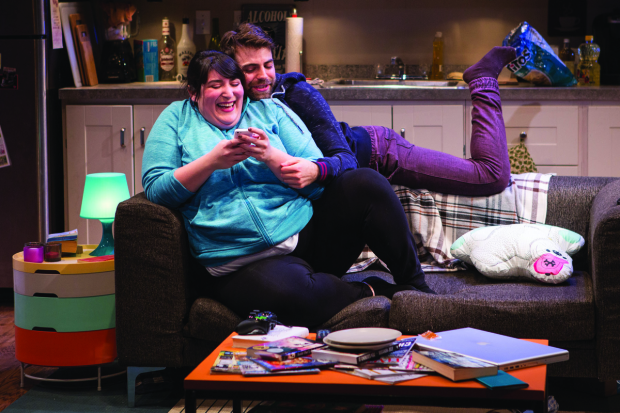I Wanna F*cking Tear You Apart

(© Teresa Wood)
Studio Theatre, as part of Studio R&D, its new works initiative, is producing the world premiere of I Wanna F*cking Tear You Apart, written and directed by Morgan Gould. The play's title, which is a reference to a song in the television show American Horror Story: Hotel, is a tribute to that show and the way Gould feels its makers understand what she calls "gay tropes."
The play is a tale of a unique friendship and the ways that friendships are tested and seen in both their strongest and weakest moments. The main characters in the play are Leo, a young gay man, and Sam, who self-identifies as a fat girl. They live together and share many of the same interests in a tight, codependent blur. They both want to be writers, but only Sam spends enough time daily writing to allow her to qualify someday as a capable writer. Most of the time the duo spend watching a lot of television, so their references to shows like "Top Chef," "Sex and the City," and "Grey's Anatomy" are plentiful.
The play comprises many short scenes that serve to elaborate on Sam's and Leo's personalities and the balance of their friendship. Leo, it turns out, always borrows money from Sam, who seems to buy all their food, even though Leo has a job. Though Sam has a boyfriend, she continually tells Leo that he is the only person she loves unconditionally.
Their close relationship begins to unravel, however, when Sam realizes that Leo has a new female companion at work, Chloe. Chloe is everything Sam will never be. She is razor thin. She wears trendy clothes. She has lovely strawberry-blond hair. Sam immediately hates her and can't forgive Leo for liking her. Sam pours herself into writing her book, which Leo edits. The book gets published. There is a marvelous surprise twist to the play that shows just what a lively imagination Gould possesses as a storyteller.
Nicole Spiezio is fascinating as Sam, who goes through a broad range of emotions as she moves from love and trust to anger, mistrust, and disgust with Leo. She manages to strike a delicate balance portraying a woman who is strong, not sad, who resists people who would feel sorry for her because of the way she looks. She makes it clear that her value comes from her intelligence, not the success of a conventional romantic relationship.
Tommy Heleringer is excellent as the sprightly Leo, a slender young man with boundless energy and what Sam calls "John Stamos hair."
It is very possible that Leo could have been insensitive enough to Sam's needs not to realize how she would respond to Chloe. It's possible that the exuberant Leo just doesn't think about the consequences when he brings Chloe home to meet Sam. It's possible he simply wants everyone to love everyone he loves. Possible, but not probable.
Anna O'Donoghue is hilarious as the flighty Valley girlish Chloe, who instantly offends Sam by effusively oozing compliments. Bouncing all over Sam's couch, Chloe flatters everything about Sam, from her organization to the way she stays at home to write, turning what should be a compliment into an insult when she notes that by working in her pajamas all day, Sam probably saves money by not buying clothes.
Gould directs her work with a deft hand. There are no dead moments and no pauses. Lighting designer Andrew Cissna creates surtitles over the stage, pointing out which month will be illuminated in the upcoming scene. Set designer Luciana Stecconi has created Leo and Sam's apartment, as a kitchen against the back wall of the stage with bedrooms offstage left and offstage right. The central area is full of books, knickknacks, a lava lamp, a Greek statue draped in a hot-pink boa, wearing a cowboy hat.
For much of the show though, Sam and Leo sit on a sofa facing the audience, staring at an unseen television set.
There is a pre-show high drag moment for which costume designer Ivania Stack goes appropriately wild, dressing Heleringer in a chartreuse brocade suit with a high collar. Spiezio gets a purple wig and long red feather with which she whips Heleringer, whom Stack clothes in a variety of jeans and T-shirts. Spiezio gets black tights and many different colored blouses.
The purpose behind this play is to change how society thinks about the ways people really look and live, beyond the stereotypes. Gould's sensitive writing about Sam coupled with Spiezio's exceptional portrayal of her should go a long way to helping to create that change so that people can be seen as they really are, beyond the glare of our television screens.











